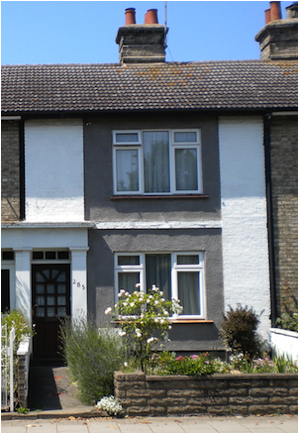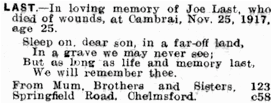Joseph ‘Joe’ Last came to Chelmsford from Suffolk where he had been a gardener. He joined the army in January 1916, landed in France in October 1916. He died from wounds received in November 1917 at the Battle of Cambrai. His home was in Springfield Road.
LAST, JOSEPH,
Private, 11th (Service) Battalion, Middlesex Regiment (formerly of the Essex Regiment)
Headquarters. Eventually found a suitable dug-out in the Hindenburg Line, R.16.d.6.1 Battalion started one tank short, one tank also stuck in our old front line. Battalion gained all its objectives well up to time, and reorganisation and consolidation taken in hand at once. Total captures about 150 prisoners, including a regimental commander and several officers, 6 machine guns all in working order, two handed over to a tank and taken on to Masnières, various Granatternwerfer and ammunition and materials, a dug-out containing quartermaster’s stores, etc. Bosche headquarters, probably near Cambrai, were still ringing up to this dug-out several hours after we had gained our objective. Casualties; Capt. E. A. Moore, Capt. G. T. Whinney, Lieut. Hedgecock, 2/Lieut. Sewell, 2/Lieut. Angrave wounded, and about 90 other ranks’.”
Joe, who was one of those 90, died from his wounds on 21st November 1917 having been evacuated south-west from the battlefield to Tincourt. He was aged 25. He is buried at Tincourt New British Cemetery, Somme, France (grave: II. G. 3), about seven kilometres east of Peronne. Tincourt was a centre for Casualty Clearing Stations between May 1917 and March 1918.

Joe was born at Long Melford, Suffolk in 1891, the second son of William Last and Lucy Last (nee Pleasants). His father had been born in 1861; his mother in 1859. The couple had married in Suffolk in 1881 and in 1891 had been living at Church Walk in Long Melford.
Joe’s ten siblings included Lily Last (born c1884), William John Last (born in 1886), Mary Ellen ‘Nellie’ Last (born in 1889), Fred Last (born in 1894), Edith Jessie Last (born in 1896) and Flossie Last (born in 1900). The whole family, apart from Joe’s father (who was born in Diss, Norfolk), were born in Long Melford.
The 1901 census found Joe aged nine, living with his parents and five siblings in Bridge Street, Long Melford. His father was a mat weaver, his mother a horse hair weaver and his brother John, a cattle stock man on a farm.
A decade later Joe was recorded by the 1911 census living with George and Annie Letts at Cemetery Road in Hadleigh, Suffolk, along with his sister Lily who was a domestic cook. 19 year-old Joe was a gardener for George Letts, nurseryman.
Two years later Joe and his family moved to Chelmsford.
Early in 1916 he enlisted into the army at Chelmsford and served as Private 4315
in the Essex Regiment. He landed in France in October 1916.
He subsequently joined the 11th (Service) Battalion of the Middlesex Regiment. serving as Private G/34202. The battalion was attached to the 36th Brigade in the 12th (Eastern) Division, and had arrived in France in July 1915.
Joe was wounded on 20th November 1917 at the start of the Battle of Cambrai, famous for the successful use of tanks to breach the German Hindenburg Line. On that day Joe’s battalion was at Gonnelieu, south of Cambrai, charged with the objectives of capturing Black Line (which ran between Bleak Support to Village Line), Blue Line (north-east of Black Line), and Brown Line (which included Lateau Wood and the Hindenburg Support Line as far as Vacquerie Valley). Joe’s brigade and the 35th Brigade were allotted the Black and Blue Lines, while his brigade and the 37th Brigade were given the left and right elements of the Brown Line respectively. A post war account of the Middlesex Regiment reported:
“Seventy-two tanks were allotted to the 12th Division, i.e., 48 for the Blue Line and 24 for the Brown Line. They were to form up 1,000 yards from the German front line and the infantry behind them. Every precaution to prevent the enemy obtaining information concerning the impending attack had been taken and extraordinary measures resorted to to keep the operation secret.
‘Zero’ was at 6.20 a.m. on 20th November and at that hour the tanks, moving forward in advance of the infantry, literally fell upon the enemy’s wire, tearing great lines in it through which the troops passed. Protected by smoke barrages which ‘blinded’ the enemy’s artillery, the tanks rolled on across the German trenches, smashing up the enemy’s machine guns and driving his troops to ground. The British infantry, following close behind the tanks, cleared the Germans from their dug-outs and shelters, whilst the tanks patrolled the line of hostile trenches. The surprise of the enemy was complete, Both the main Hindenburg Line and its outer defences were quickly overrun, and the attack then swept on to the Hindenburg Support Line.
The 11th Middlesex thus relate their part in the attack: ‘Formed up behind our tanks - 12 per battalion - ‘C’ and ‘B’ Companies in the first wave, ‘A’ and ‘D’ in the second, all ready by 3.45 a.m. The Battalion attacked the furthest objective (Brown Line apparently) and formed up 800 yards in rear of the leading battalions.’ Zero minus ten minutes, tanks and infantry moved off. No excitement on the part of the Huns except one machine gun. Our guns started off at Zero (6.20 a.m.) Battalion Headquarters in Gun Support. 2/Lieut. Chippenfield went off to find a new Battalion Headquarters 8.25 a.m. 9.25 a.m. - No news from Chippenfield. Moved off in three parties to find a new Battalion

On 21st December 1917 the Essex Weekly News reported:
“Pte. Joe Last, Middlesex regt., died of wounds received in action on Nov. 20th, was the second son of Mrs. Last, Springfield-rd., Chelmsford. He enlisted in the Essex Regt., in January 1916, and landed in France in October of the same year. His sergeant, writing to Mrs. Last, says: ‘I was with him at the time he was hit by machine gun fire, and saw him fall. I did not think he was badly wounded, as I called out to him when he fell, asking him if he was badly hit; but he spoke cheerfully and his words were, ‘go on, Sergeant; I’m all right.’ I can’t express how sorry the boys and myself are. You have every reason to be proud of him; he fell like a soldier and a brave man, face to the enemy, and I am very proud to have him in my platoon.’ Deceased, who was 25 years of age, died at a clearing station the day after he was wounded.”
A week later the Essex County Chronicle reported:
“Pt. Joe Last, Middlesex Regt., died of wounds received in action, aged 25, was the second son of Mrs. Last, Springfield Road, Chelmsford. He enlisted in the Essex Regt. in January 1916.”
Joe is commemorated on the Civic Centre Memorial, Chelmsford, the Long Melford War Memorial, Suffolk, and on the Springfield Parish Memorial at All Saints’ Church.
The 1918 register of electors listed Joe’s mother at 123 Springfield Road, Chelmsford (later numbered 285, pictured).
Joe’s brother, Fred. died in 1929 as a result of ‘privations endured while serving with H.M. Forces in the war.’
Joe’s mother died in 1935, aged 75.
131113

